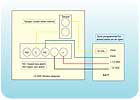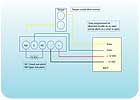
Properly designing a burglary system requires an extensive knowledge of detection devices as well as an understanding of the electrical properties of the devices, the needs of the customer and the vulnerability of the premises to be protected. To see if you possess the knowledge to properly design a system to detect burglaries, take the following quiz.
ANSWERS BELOW.

What’s Wrong with This?
Wally `Larman installed a burglary alarm system that included several motion detectors. Wally made home runs for all the wiring and connected each device to its own zone as shown in this diagram. After completing all the work and programming the control, Wally fully tested the system and was satisfied that everything was working, but when the inspector arrived, he was not happy. Can you see what Wally did wrong and what he must do to correct the problem?- Multiple alarm contacts that open when in alarm should be wired in:
- parallel.
- series.
- either series or parallel.
- You cannot connect multiple devices.
- Multiple alarm contacts that short when in alarm should be wired in:
- parallel.
- series.
- either series or parallel.
- You cannot connect multiple devices.
- What is the total current draw of a circuit that has 10 motion detectors if each unit requires .035 amps?
- .35 mA
- 3.5 mA
- 35 mA
- 350 mA
- Shock sensors can be used to protect:
- glass.
- doors.
- solid walls.
- All of the above
- None of the above
- Microwave detectors are most sensitive to motion toward and away from the detector.
- True
- False
- Which of the following can be used as a motion detector?
- Dual-technology detectors
- Microwave detectors
- PIRs
- PE beams
- Any of the above
- PIR detectors are most sensitive to motion toward and away from the detector.
- True
- False
- Sound detectors can be used to protect:
- glass.
- doors.
- solid walls.
- Vaults.
- Any of the above
- All magnetic switches use biased contacts.
- True
- False
- The eol (end of line) always should be installed at the control panel.
- True
- False
- Which of the following common construction materials can microwaves not penetrate?
- Glass
- Metal
- Sheetrock
- Wood
- All of the above
- None of the above
- Most PIRs on the market today transmit on a frequency of 40 KHz.
- True
- False
- Wireless detection devices are not listed for use on UL installations.
- True
- False
- You can increase the standby time of any system by adding as many batteries as necessary to achieve the desired time.
- True
- False
- What size of standby battery should you use to provide four hours of standby for a burglary system that draws 750 mA?
- 1 AH
- 2 AH
- 4 AH
- Any of the above
- None of the above
5-Minute Tech Quiz Answers
Here are the answers to the 5-Minute Tech Quiz and What’s Wrong with This?- b
- a — When wiring multiple devices that short on alarm in parallel, it is critical to install the eol at the end of the run and not to T-tap cable runs to ensure complete supervision.
- d — When calculating the total current of a system, you must add the current draw of each device.
- d
- a — Because microwave detectors operate by using the Doppler shift principle, they are most sensitive to motion toward or away from the unit.
- e
- b
- e
- b
- b — The eol resistor always should be located at the end of the line in the last device. This is done to provide supervision for the circuit, because installing the eol inside the control will show a short on the wire as a normal circuit.
- b
- b — PIRs are passive devices and as such do not emit any energy.
- b
- b — Each control or power supply has a maximum size of battery that can be charged. You should check with the manufacturer to determine the size of batteries you can use safely.
- c – To provide four hours of standby time for a system that draws 750 ma, you will need 4 x 0.750, which equals three amp-hours of battery. Use a slightly larger battery to allow for battery condition and alarm time, which typically use more current than normal operation.

Answer to: What’s Wrong with This?
Wally’s problem is caused by where he located the eol resistor. By installing it inside the BACP, the control cannot properly supervise the wire to the device, since a short on the wires going to the detector will cause the zone to remain normal but render it incapable of detecting an alarm. Wally should rewire the zone as shown in this diagram using the alarm relay contacts that short on alarm for motion and the tamper contacts that open on alarm, allowing the control to differentiate between a tamper/broken wire and motion activation. Wally can program the zone to respond to an open during the disarmed period as a trouble, if the control supports this type of zone response. This will provide immediate notification even during the disarmed period. The alternate wiring diagram provides the same 24-hour supervision of the tamper, but by using both the NC and NO relay contacts, it provides additional assurance that an alarm will be received even if the alarm relay contacts become dirty.